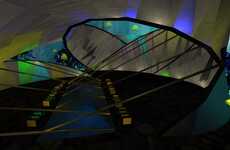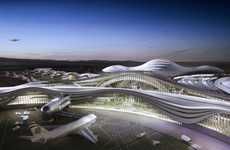
EcoNET Challenges Current Building Practices
Amelia Roblin — September 13, 2012 — Eco
References: cargocollective & suckerpunchdaily
In anticipation of a future world that's lacking in many of the familiar organic species of today and greatly altered due to the destructive impact that human industries have on the planet, EcoNET by Masha Pekurovsky poses questions about the way we may need to start building. As the subject of a thesis project for a Master of Architecture, this 'Project_4' demonstrates the possible integration of living materials with artificial ones.
The creator aimed to explore the ways that architecture could become "a platform, a monitor, a remediator, an interface, a harvester, a partner and so on." Occupiable structures could become practical for human use but beneficial to the environment as well. EcoNET by Masha Pekurovsky suggests that buildings could give back to the earth and keep constant surveillance on its health to strike a harmony between between what's synthetic and natural.
The creator aimed to explore the ways that architecture could become "a platform, a monitor, a remediator, an interface, a harvester, a partner and so on." Occupiable structures could become practical for human use but beneficial to the environment as well. EcoNET by Masha Pekurovsky suggests that buildings could give back to the earth and keep constant surveillance on its health to strike a harmony between between what's synthetic and natural.
Trend Themes
1. Living Materials Integration - The integration of living materials with artificial ones in architecture opens up the possibilities for eco-friendly structures that benefit both humans and the environment.
2. Environmental Monitoring Architecture - Architecture that serves as a monitor and surveillance system for the health of the environment presents opportunities for creating sustainable and proactive structures.
3. Earth-friendly Building Practices - Building practices that give back to the earth and aim to strike a balance between synthetic and natural materials offer opportunities in eco-friendly construction.
Industry Implications
1. Construction Industry - The construction industry can leverage the integration of living materials with artificial ones to create environmentally friendly structures that align with future sustainability goals.
2. Architecture Industry - Architects can explore the implementation of environmental monitoring systems in their designs to create surveillance-based structures that prioritize the health of the planet.
3. Sustainable Design Industry - The sustainable design industry can drive the adoption of earth-friendly building practices that consider the impact of construction on the environment and maximize its benefits.
5.8
Score
Popularity
Activity
Freshness























